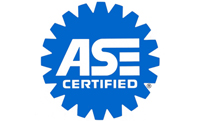Alignment
What are the significant causes of excessive tire wear

Uneven or accelerated tire wear can be caused by wheel
misalignment, worn suspension and steering components,
and/or improper tire inflation.
The most critical alignment angle with respect to tire wear
is toe. Camber is also important and can be affected by
caster. Misalignment is usually caused by worn, loose or
bent suspension and steering parts (bad tie rod ends, idler
arms, control arm bushings, ball joints, struts, etc.), but
can also be due to spring sag or improper ride height.
With tire inflation, underinflation is just as bad as
overinflation. Both can cause uneven tire wear.
Underinflation can also make a tire run dangerously hot.
For a tire to roll down the road with the least amount of
resistance and maximum directional stability, it must be
aligned with the road, parallel to the other three wheels on
the vehicle, square with the chassis, and properly inflated.
Rolling resistance is affected by a number of things, one of
which is the straightness of the tire with respect to the
direction of travel. If the tire is skewed slightly to one
side or the other (toed in or out), it will scrub as it
rolls. Scrub increases rolling resistance and also wears
away the tread, leaving a feathered wear pattern.
Toe refers to the parallelism of a front or rear wheel to
its companion on the opposite side. From a bird's-eye view,
all four wheels should be parallel to one another and
pointing straight ahead.
Toe is measured by comparing the distance between the front
edges of both tires on an axle to the distance between the
trailing edges. If the distance between the front edge is
further apart than that at the rear, wheels have toe-out.
If front is closer together than rear, wheels have toe-in.
Toe settings may be specified in inches, millimeters or
degrees. Toe is most affected by worn tie rod ends, a worn
or loose idle arm or center link, or a bent steering arm.
To minimize tire wear, rolling toe should be kept as near
zero as possible. To achieve this, the compliance or amount
of give in the vehicle's steering linkage and suspension
must be taken into consideration.
As a vehicle starts to move, rolling resistance pushes the
tires back. This compresses the couplings and rubber
fittings in the steering linkage and causes the wheels to
toe-out slightly. It isn't much of a change, but most
rearwheel drive vehicles call for static toe-in settings of
around 1/16" to 1/8" to compensate.
With front-wheel drive, the situation is different because
the front wheels pull the vehicle down the road. Engine
torque causes the wheels to toe-in under load. Most FWD
suspensions have a negative scrub radius built into the
steering geometry.
The tire pivots slightly to the outside of its centerline.
This helps to offset the tendency to toe-in. Even so, most
front-wheel drive vehicles still require toe settings of
zero to 1/8" toe out.
Toe also changes as the front wheels turn. Because the inner
and outer wheels don't follow the same path (the inner one
follows a smaller circle than the outer one), the inner
wheel must toe-out to compensate. This is called the
"Ackerman Principle of Steering" after the engineer who
invented the idea.
Toe-out depends on the angle of the steering arms with
respect to the steering knuckles and chassis. The amount by
which toe changes is called "toe-out on turns." This angle
is also listed in alignment specs and is checked by turning
the wheels on the alignment rack.
If toe-out on turns is off because of a bent steering arm,
the tires will squeal and scrub whenever the wheels are
steered.
Camber also affects tire wear. For directional stability,
the tires must be perpendicular (straight up and down) with
respect to the road. Any tilt to the inside or outside will
cause a tire to turn in that direction like a bicycle
leaning into a turn. This causes steering to pull to one
side and creates uneven wear across the tread face.
Camber is the inward or outward tilt of the wheels as viewed
from either front or rear of the car. If wheels lean in,
they have negative camber. If they lean out, they have
positive camber.
The amount of camber is always expressed in degrees and is
found by measuring the tilt of the wheels on an alignment
rack or by using a level that attaches to the wheel.
Because camber affects tire wear, the ideal situation is to
have zero running camber on all four wheels to maintain full
tread contact with the road. Like toe, camber changes as the
suspension moves up and down. To keep the wheels vertical
once the vehicle is loaded, a small amount of static
positive camber may be required.
Camber should generally be within 1/2 degree side-to-side.
Otherwise, the vehicle will lean toward the side with the
most positive camber.
Camber misalignment can be caused by a sagging spring, a
bent strut, bent spindle, worn control arm bushing, worn
ball joint, or mislocated strut tower (too far in or out).
Camber corrections are made by replacing worn parts and/or
by realigning the suspension using either the factory
adjustments (cams, shims or elongated holes) or aftermarket
aids.
OneStop Auto Shop
Call Today for
all of your Auto Repairs
and Maintenance
in Hollywood, Ca.!
(323) 227-9999
|























